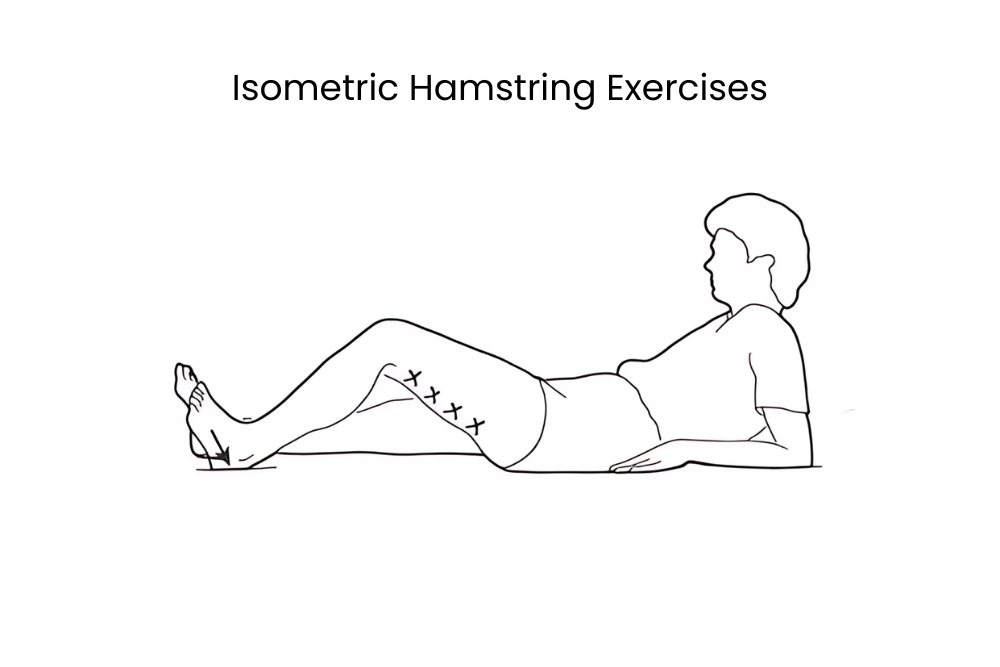
Isometric hamstring exercises are an effective way to strengthen the muscles in the back of the thigh. These exercises involve holding a static position for a set period of time, rather than performing dynamic movements like squats or lunges. Isometric exercises can be done with or without equipment, making them a versatile option for people looking to improve their hamstring strength.
Contents
One of the benefits of isometric hamstring exercises is that they can help to prevent injury. Strong hamstrings can help to support the knee joint and prevent strains or tears. Additionally, isometric exercises can be done in a pain-free range of motion, making them a good option for people who are recovering from an injury or dealing with chronic pain. However, it is important to note that isometric exercises should be done in conjunction with other types of exercise, as they do not provide a cardiovascular workout.
Another benefit of isometric exercises is that they can be done anywhere, at any time. Unlike some other types of exercise that require equipment or a gym membership, isometric exercises can be done in the comfort of your own home. This makes them a convenient option for people who are short on time or don’t have access to a gym. Overall, isometric hamstring exercises are a valuable addition to any fitness routine, providing a low-impact way to build strength and prevent injury.
Basics of Isometric Hamstring Exercises
Isometric hamstring exercises are a form of strength training that involves contracting the hamstring muscles without changing their length. This type of exercise is particularly beneficial for improving muscle strength, endurance, and stability.
One of the key benefits of isometric hamstring exercises is that they can be performed with little to no equipment, making them an ideal choice for people who prefer to exercise at home or who do not have access to a gym. Additionally, isometric exercises are low-impact and can be performed by people of all fitness levels.
To perform an isometric hamstring exercise, an individual should contract their hamstring muscles and hold the contraction for a set period of time, typically between 5 and 10 seconds. This can be done in a variety of positions, such as standing, sitting, or lying down.
Some examples of isometric hamstring exercises include the single-leg bridge, standing iso leg curl, and single-leg iso deadlift. These exercises can be performed individually or as part of a larger workout routine.
Overall, isometric hamstring exercises are a safe and effective way to improve muscle strength and endurance. By incorporating these exercises into their workout routine, individuals can improve their overall fitness and reduce their risk of injury.
Equipment and Setup for Isometric Hamstring Workouts

Isometric hamstring exercises can be performed using a variety of equipment such as resistance bands, stability balls, and exercise mats. Here are some tips on how to set up your equipment for an effective isometric hamstring workout.
Using Resistance Bands
Resistance bands are a great tool for isometric hamstring exercises. They are lightweight, portable, and easy to store. To set up for an isometric hamstring workout with resistance bands, follow these steps:
- Choose a resistance band with appropriate tension for your fitness level.
- Secure one end of the resistance band to a stationary object, such as a door handle or sturdy piece of furniture.
- Loop the other end of the resistance band around your ankle.
- Stand with your back to the stationary object and extend your leg straight out behind you.
- Hold the position for 10-30 seconds, then release and switch legs.
Stability Balls and Exercise Mats
Stability balls and exercise mats can also be used for isometric hamstring exercises. Here’s how to set up for this type of workout:
- Place an exercise mat on the floor.
- Lie face down on the mat with your legs straight out behind you.
- Place a stability ball between your feet.
- Squeeze the stability ball with your feet and hold for 10-30 seconds.
- Release and repeat for several reps.
Using equipment for isometric hamstring exercises can help increase the intensity and effectiveness of your workout. However, it’s important to choose equipment that is appropriate for your fitness level and to use proper form to avoid injury.
Isometric Hamstring Exercise Variations
Isometric hamstring exercises are an excellent way to build strength and stability in the hamstrings. They are also a great way to prevent injuries. Here are three variations of isometric hamstring exercises that you can try:
Standing Hamstring Holds
Standing hamstring holds are a simple and effective way to strengthen the hamstrings. To perform this exercise, stand with your feet hip-width apart and your knees slightly bent. Then, lift one foot off the ground and hold it in the air for 10-15 seconds. Repeat with the other leg.
Seated Isometric Tensions
Seated isometric tensions are another great way to work the hamstrings. To perform this exercise, sit on the edge of a chair with your feet flat on the ground. Then, press your heels into the ground as hard as you can for 10-15 seconds. Relax and repeat.
Lying Leg Curls
Lying leg curls are a more advanced isometric hamstring exercise. To perform this exercise, lie on your stomach with your legs straight. Then, lift one leg off the ground and hold it in the air for 10-15 seconds. Repeat with the other leg.
These three isometric hamstring exercises are a great way to build strength and stability in the hamstrings. They are also a great way to prevent injuries. Try incorporating them into your workout routine for best results.
Incorporating Isometric Hamstring Exercises into a Routine
Isometric hamstring exercises can be a valuable addition to any workout routine, helping to improve strength, stability, and flexibility in the lower body. Here are some considerations for incorporating these exercises into a routine:
Warm-Up Considerations
Before beginning any exercise routine, it is important to warm up properly. This can help to prevent injury and prepare the body for the workout ahead. For isometric hamstring exercises, a warm-up might include light jogging, brisk walking, or dynamic stretches such as leg swings or hip circles.
Integration with Dynamic Exercises
Isometric hamstring exercises can be integrated into a workout routine alongside dynamic exercises such as lunges, squats, and deadlifts. This can help to improve overall lower body strength and stability. For example, a workout might include a combination of single-leg bridges, standing isometric leg curls, and single-leg isometric deadlifts, alongside dynamic exercises such as lunges and squats.
Cool-Down and Stretching
After completing a workout, it is important to cool down and stretch the muscles to prevent injury and promote recovery. This might include static stretches such as hamstring stretches, calf stretches, and quad stretches. It is important to hold each stretch for at least 30 seconds and avoid bouncing or overstretching the muscles.
Overall, incorporating isometric hamstring exercises into a workout routine can be a great way to improve lower body strength, stability, and flexibility. By warming up properly, integrating with dynamic exercises, and cooling down and stretching afterwards, individuals can help to prevent injury and promote recovery.
Frequently Asked Questions
What are the best seated isometric exercises for strengthening hamstrings?
Seated isometric exercises are an excellent way to strengthen the hamstrings. One of the best exercises is the seated leg curl. This exercise involves sitting on a bench with your legs extended in front of you and a resistance band wrapped around your ankles. Then, you pull your heels towards your body, contracting your hamstrings and holding the position for 10-15 seconds before releasing. Another great exercise is the seated hamstring press, which involves sitting on the edge of a bench with your legs extended in front of you and a resistance band wrapped around your ankles. Then, you push your heels away from your body, contracting your hamstrings and holding the position for 10-15 seconds before releasing.
How can isometric exercises be incorporated to target both hamstrings and glutes effectively?
Isometric exercises can be used to effectively target both the hamstrings and glutes. One example is the single-leg bridge, where you lie on your back with one foot on the ground and the other leg extended in the air. Then, you lift your hips off the ground, contracting your glutes and hamstrings, and hold the position for 10-15 seconds before releasing. Another example is the standing hamstring curl, where you stand with your feet hip-width apart and a resistance band wrapped around your ankles. Then, you lift your heel towards your buttocks, contracting your hamstrings and glutes, and hold the position for 10-15 seconds before releasing.
What are the potential disadvantages of relying solely on isometric exercises for hamstring development?
While isometric exercises can be effective for hamstring development, relying solely on them may not be the best approach. Isometric exercises do not involve a full range of motion, which means they may not stimulate muscle growth and strength to the same extent as exercises that involve both concentric and eccentric contractions. Additionally, isometric exercises may not be as effective for improving muscle endurance as other types of exercises.
Are there specific isometric exercises recommended for hamstring tendinopathy rehabilitation?
Yes, there are specific isometric exercises recommended for hamstring tendinopathy rehabilitation. One example is the Nordic hamstring curl, which involves kneeling on a mat with your feet anchored and slowly lowering your upper body towards the ground while contracting your hamstrings. Another example is the isometric hamstring bridge, where you lie on your back with your knees bent and your feet flat on the ground. Then, you lift your hips off the ground, contracting your hamstrings, and hold the position for 10-15 seconds before releasing.
How do isometric holds contribute to tendon strength and health?
Isometric holds can contribute to tendon strength and health by increasing the load on the tendon without subjecting it to excessive force or motion. This can help to stimulate the production of collagen, which is the main structural protein in tendons. Additionally, isometric holds can help to improve the neuromuscular control of the tendon, which can reduce the risk of injury and improve overall tendon health.
Can consistent isometric training lead to significant muscle growth in the hamstrings?
While consistent isometric training can lead to muscle growth in the hamstrings, it may not be as effective as other types of training. Isometric exercises primarily target the slow-twitch muscle fibers, which are responsible for endurance and not as much for muscle growth. To achieve significant muscle growth in the hamstrings, it may be necessary to incorporate other types of exercises that involve both concentric and eccentric contractions.
